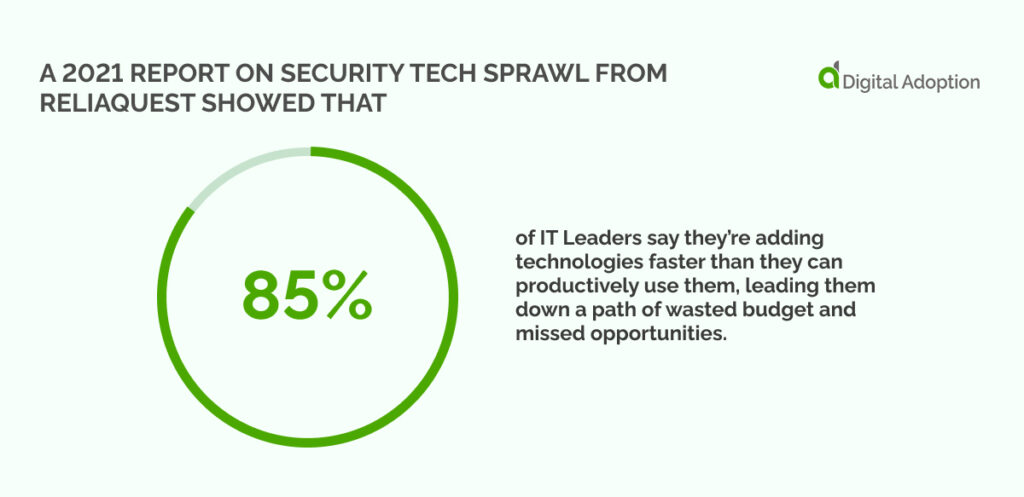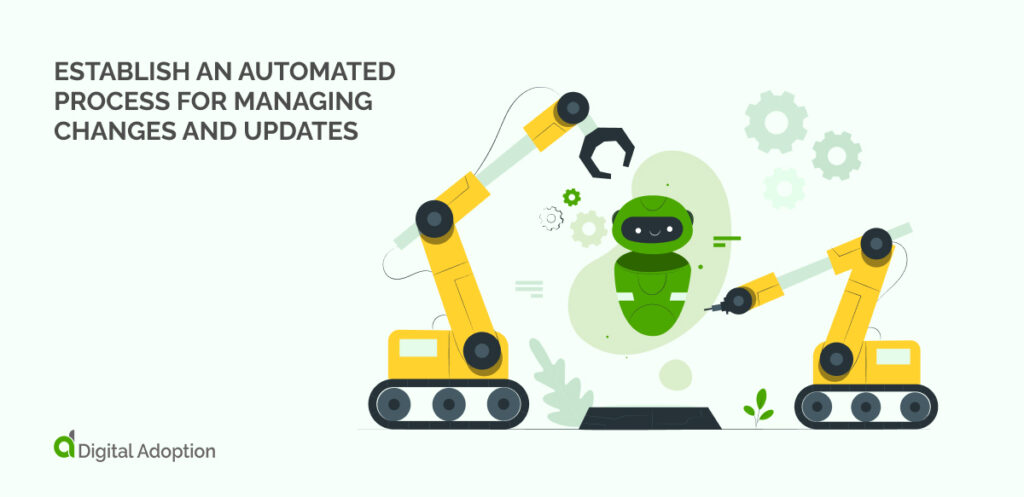Tech sprawl is a form of digital transformation— intentionally paring down your tech stack is one of the most effective ways to cut costs and streamline processes.
To overcome tech sprawl, you’ll also need a robust approach to digital adoption. Eliminating tech sprawl isn’t just about canceling contracts and uninstalling software— sometimes, it involves finding a new digital solution that does the job of 5 others.
An economic downturn is on the cards. CIOs, business leaders, and the like are looking for ways to stay competitive through the rough seas on the horizon.
At the same time, new digital technology innovations and features are being added to existing solutions. It’s hard to keep up with all the changes, making your business susceptible to tech sprawl.
Tech sprawl is a common problem. It’s when a business has more digital tools than it needs. Sometimes this is because of organizational siloes that have specific requirements. Sometimes this is because multiple vendors roll out the same added features, creating redundancy in your tech stack.
You end up paying more for tools or features you’re not using.
A 2021 report on security tech sprawl from ReliaQuest showed that 85% of IT leaders say they’re adding technologies faster than they can productively use them, leading them down a path of wasted budgets and missed opportunities.

The good news is that there are solutions available.
In this article, we will explain how to identify tech sprawl within your organization and explore some of the challenges and strategies involved with overcoming tech sprawl.
How To Identify Tech Sprawl and Determine its Impact

If your company’s tech stack is becoming increasingly complex, you might be experiencing tech sprawl. You’ve accumulated too many IT systems, tools, and services that are not connected, which leads to significant inefficiencies.
To identify tech sprawl, you can start by mapping out your company’s current tech landscape and analyzing the connections between each system.
Then, evaluate the impact of this sprawl on your business, such as how it affects your team’s productivity and your company’s bottom line. To do this, you need to understand which teams use which tools and for what purpose.
Digital employee experience (DEX) solutions are well-suited to help you gather this information. Many popular DEX solutions can collect usage data so you can track who’s using what. They also collect qualitative, holistic data about how useful your employees think their digital tools are.
Both kinds of data are essential for coloring the full picture of the tech sprawl’s impact on your business.
The Hardest Part of Overcoming Tech Sprawl

Without a doubt, identifying tech sprawl and measuring its impact on your organization is difficult. It requires data analysis, strategy, and stretching your vision as far as possible. But it’s not the hardest part of combatting tech sprawl.
The hardest part is people.
One of the main causes of tech sprawl is that employees resist change and often develop an affinity for the software they know.
They don’t communicate their knowledge across organizational siloes, and you end up with pockets of the business, mostly doing similar things but using different tools.
To overcome tech sprawl, you need to approach it as a cultural shift and a technological one.
Eliminating tech sprawl results from a series of small digital transformations chained together, so the sooner you can establish a transformation-friendly culture, the better.
How To Overcome Tech Sprawl
Let’s unpack some of the smaller digital transformations you can carry out, which, once chained together, will lead to you overcoming tech sprawl.
Implement a Strategy to Reduce the Complexity of Processes

In today’s fast-paced world, complexity is major hurdle businesses face daily.
Implementing a strategy to reduce the complexity of processes and systems can be a game-changer.
Not only does it streamline operations, but it also helps you focus on mission-critical priorities and what makes your business stand out from the competition. It allows employees to develop their skills and explore new business opportunities.
However, simplifying processes and systems is easier said than done. It requires concert effort, a clear understanding of the organization’s goals and objectives, and close collaboration between all stakeholders.
At the same time, the benefits of reducing complexity are significant, making this strategy an essential part of any forward-thinking business plan.
Re-evaluate Current Technology Investments

You can improve workflows and streamline processes by shifting priorities to more efficient solutions.
This saves time and money and ensures that you’re up to date with the latest technological advancements.
Don’t be afraid to closely examine your current investments and adjust as needed. And remember, your goal is to reduce spending while increasing productivity at the same time.
It sounds too good to be true, but it’s possible.
Establish an Automated Process for Managing Changes and Updates

As technology platforms continue to evolve and improve, keeping up with the latest changes and updates can be a daunting task that, if mishandled, leads to tech sprawl.
That’s why developing an automated process for managing these changes is crucial for any business looking to stay ahead of the curve.
Automation saves time, reduces the risk of errors, and ensures that your technology platforms are always up-to-date and performing at their best.
By implementing an automated process, you can focus on growing your business while the technology takes care of itself.
Invest in Intelligent Data Governance Tools

Investing in intelligent data governance tools is crucial to ensuring consistent data quality across all applications.
With the rise of big data, it’s more important than ever to have a system that can effectively manage and safeguard your data. These tools can help automate data quality tasks, identify errors and inconsistencies, and enforce data governance policies across your organization.
On top of that, data governance tools can manage data across applications, which makes it easier for separate business teams to collaborate.
Create an End-User Experience Roadmap

When it comes to improving employee productivity, having a well-thought-out end-user experience roadmap can make a world of difference.
By creating a roadmap, you can identify pain points in your current system and strategically implement changes to streamline processes and enhance overall user experience.
By involving employees throughout the process, you can also ensure that their needs and preferences are considered.
Whether you’re improving software, hardware, or communication systems, having a strong roadmap can help you get the most out of your investments while empowering your team to work smarter, not harder.
Tighten Up Your Tech Stack Today

Tech sprawl is a real issue that can lead to lengthy and costly business operations.
By understanding the causes and symptoms of tech sprawl, you can more effectively identify and address this challenge.
Eliminating tech sprawl isn’t easy, but by taking a long-term view of the problem and implementing some of the strategies we’ve discussed, you too could have a leaner, meaner tech stack that doesn’t break the budget.




![18 Examples of AI in Finance [2025]](https://www.digital-adoption.com/wp-content/uploads/2025/06/18-Examples-of-AI-in-Finance-2025-300x146.jpg)
![14 Examples of AI in Manufacturing [2025]](https://www.digital-adoption.com/wp-content/uploads/2025/06/14-Examples-of-AI-in-Manufacturing-2025-300x146.jpg)
![29 Examples of AI in Education [2025]](https://www.digital-adoption.com/wp-content/uploads/2025/06/29-Examples-of-AI-in-Education-2025-300x146.jpg)
![15 Examples of AI in Retail [2025]](https://www.digital-adoption.com/wp-content/uploads/2025/06/15-Examples-of-AI-in-Retail-2025-300x146.jpg)
![13 Examples of AI in Healthcare [2025]](https://www.digital-adoption.com/wp-content/uploads/2025/06/AI-in-healthcare-examples-300x146.jpg)


![18 Examples of AI in Finance [2025]](https://www.digital-adoption.com/wp-content/uploads/2025/06/18-Examples-of-AI-in-Finance-2025.jpg)
![14 Examples of AI in Manufacturing [2025]](https://www.digital-adoption.com/wp-content/uploads/2025/06/14-Examples-of-AI-in-Manufacturing-2025.jpg)
![29 Examples of AI in Education [2025]](https://www.digital-adoption.com/wp-content/uploads/2025/06/29-Examples-of-AI-in-Education-2025.jpg)